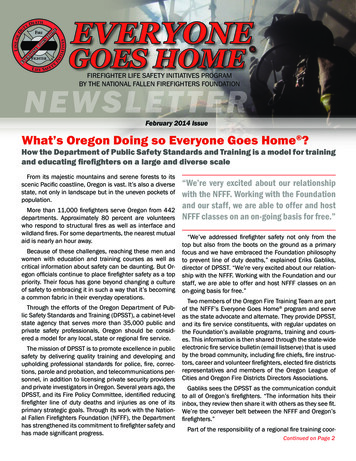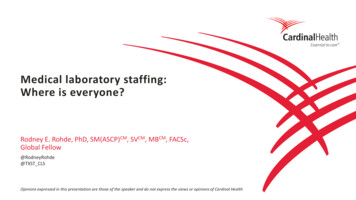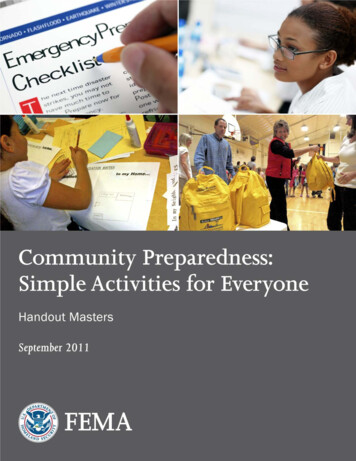
Transcription
Everyone Goes Home Firefighter life safety initiatives programby the National Fallen Firefighters FoundationNewsletterFebruary 2014 IssueWhat’s Oregon Doing so Everyone Goes Home ?How the Department of Public Safety Standards and Training is a model for trainingand educating firefighters on a large and diverse scaleFrom its majestic mountains and serene forests to itsscenic Pacific coastline, Oregon is vast. It’s also a diversestate, not only in landscape but in the uneven pockets ofpopulation.More than 11,000 firefighters serve Oregon from 442departments. Approximately 80 percent are volunteerswho respond to structural fires as well as interface andwildland fires. For some departments, the nearest mutualaid is nearly an hour away.Because of these challenges, reaching these men andwomen with education and training courses as well ascritical information about safety can be daunting. But Oregon officials continue to place firefighter safety as a toppriority. Their focus has gone beyond changing a cultureof safety to embracing it in such a way that it’s becominga common fabric in their everyday operations.Through the efforts of the Oregon Department of Public Safety Standards and Training (DPSST), a cabinet-levelstate agency that serves more than 35,000 public andprivate safety professionals, Oregon should be considered a model for any local, state or regional fire service.The mission of DPSST is to promote excellence in publicsafety by delivering quality training and developing andupholding professional standards for police, fire, corrections, parole and probation, and telecommunications personnel, in addition to licensing private security providersand private investigators in Oregon. Several years ago, theDPSST, and its Fire Policy Committee, identified reducingfirefighter line of duty deaths and injuries as one of itsprimary strategic goals. Through its work with the National Fallen Firefighters Foundation (NFFF), the Departmenthas strengthened its commitment to firefighter safety andhas made significant progress.“We’re very excited about our relationshipwith the NFFF. Working with the Foundationand our staff, we are able to offer and hostNFFF classes on an on-going basis for free.”“We’ve addressed firefighter safety not only from thetop but also from the boots on the ground as a primaryfocus and we have embraced the Foundation philosophyto prevent line of duty deaths,” explained Eriks Gabliks,director of DPSST. “We’re very excited about our relationship with the NFFF. Working with the Foundation and ourstaff, we are able to offer and host NFFF classes on anon-going basis for free.”Two members of the Oregon Fire Training Team are partof the NFFF’s Everyone Goes Home program and serveas the state advocate and alternate. They provide DPSST,and its fire service constituents, with regular updates onthe Foundation’s available programs, training and courses. This information is then shared through the state-wideelectronic fire service bulletin (email listserve) that is usedby the broad community, including fire chiefs, fire instructors, career and volunteer firefighters, elected fire districtsrepresentatives and members of the Oregon League ofCities and Oregon Fire Districts Directors Associations.Gabliks sees the DPSST as the communication conduitto all of Oregon’s firefighters. “The information hits theirinbox, they review then share it with others as they see fit.We’re the conveyer belt between the NFFF and Oregon’sfirefighters.”Part of the responsibility of a regional fire training coorContinued on Page 2
dinator is to deliver the information throughout the stateso everyone has an opportunity to learn from and sharethe resources. With 22 regional training councils justfor the fire service, information is delivered effectively.DPSST staff members attend these meetings to report onall training opportunities – not just those offered throughNFFF. Public safety chaplains who work with police andpublic safety as well as fire service also are includedin DPSST’s communications network to reinforce andstrengthen the messages.“The benefit of the NFFF resources is scalable. It’s professional, easy to package and can be delivered at anytime – day, night or weekend – to meet individual needs,”says Gabliks. “Everything is easy for all instructors to usewhich is critical for success locally, statewide and nationally.”The feedback Gabliks and his staff have received reinforces this. The instructors appreciate that everything issupported by research and the supplemental materialsmake it easy to deliver these valuable messages. This isequally important to the officers and command staff. Likewise, the people who’ve taken the classes report the information is delivered effectively and they are interestedin taking other NFFF classes.The consistency of the messages is also valuable tothe instructors and the students since there is a steadystream of new people coming into the fire service eachyear. It’s also beneficial as individuals rise to new positions and take on new roles as chief officers. Gabliks andhis staff feel this helps to ensure that messages aboutpersonal safety and accountability become part of routineconversations and expectations.The DPSST is committed to sharing new informationquickly from the Foundation so it’s in the hands of thosewho need it. Their latest partnership with the NFFF isintroducing the Behavioral Health Program that was released earlier this year and specifically the Stress FirstAid training class. They plan to also introduce LACK and asuicide prevention program soon.“Stress first aid was exactly what we needed. Last yearin our state we had four people within public safety diefrom suicide, including one firefighter. We need this information from the Foundation to help us address this issue,” said Gabliks.The partnership between DPSST and NFFF doesn’t endwith training and classes. They continue to support themission of the Foundation by ensuring the families andEveryone Goes Home Newsletter - February 2014“The benefit of the NFFF resources isscalable. It’s professional, easy to packageand can be delivered at any time – day,night or weekend – to meet individualneeds,” says Gabliks. “Everything is easyfor all instructors to use which is critical forsuccess locally, statewide and nationally.”fire service survivors are honored when a firefighter diesin the line of duty.The Oregon Fire Chiefs Association has designatedDPSST as the state coordination point for the NFFF’s Local Assistance State Team (LAST) Program. This programis led by Chief Stan Gibson of the Coos Bay Fire & Rescueand staffed by members of DPSST’s fire certification section. Oregon’s LAST Program had six activations withinthe past year to assist with traumatic incidents experienced during one of the worst wildfire seasons the statehas experienced in many decades.DPSST also coordinates the Oregon Public Safety Memorial Fund Board. The fund provides financial assistanceto public safety officers who are permanently and totallydisabled as a result of a line of duty injury, and to family members of the public safety officers who have beenkilled or permanently and totally disabled in the line ofduty. DPSST staff work with hand-in-hand with the OregonLAST to coordinate this program and assist the families involved in such incidents. This program provides an initial 25,000 lump sum payment and assistance with medical, dental, mortgage and tuition expenses.“Without question, the Department of Public SafetyStandards and Training and the National Fallen Firefighters Foundation are full-fledged partners,” says Gabliks.“We know the NFFF is a non-profit organization dedicatedto sharing solid information about firefighter safety. Weknow they need the support to get the messages out.We’ve put our checkbook behind it because we’ve foundit to be so successful.”To learn more about the NFFF’s the Everyone GoesHome programs and ideas for implementing them inyour area, go to www.everyonegoeshome.com or contactVictor Stagnaro, director of Fire Services for the NFFF atvstagnaro@firehero.org.
Now’s the Time to Keep on Keepin’ OnChief Ron KantermanAdvocate Communication ManagerEveryone Goes Home ProgramOperations, National Fallen Firefighters Memorial WeekendSo here we are 10 years later and what now? For starters, don’t think for one minute that the work we’ve beendoing with this program is all for naught. Have you everstopped to think what the numbers could be ifwe weren’t doing what we do? Looking globally, if we take Yarnell (AZ) and West (TX)out for one moment, we’d be looking at71 for 2013. It’s working.We’re always going to be subjected to system failures which shouldcause guys and gals like us to workharder and dig in deeper. Am I preaching to the choir? Perhaps. We knowthat the mission is just and the resultsare rewarding. We also know that someare getting tired, bored, uninterested anddisengaged. If this is you, bring some peoplein to the fold, sit them next to you, share your knowledge, then turn the reigns over to them. If this is not you,bring some people in to the fold, sit them next to you andshare your knowledge of the program and its related subject matter so when you’re ready to go, down the road,things can transition smoothly.None of us will be around forever but the program mustperpetuate. As we know, it’s not about us. Stay on the buswith us, drive the bus, navigate or get off at the next stop.There is no shame at hitting the bell to signal the driverto pull over. Whatever contribution you’ve made thus farwas a good contribution. No, a great contribution. It’s yourcall, but make sure what you do is right for both you, andfor the cause.When this program was developed (and someof you have been in it for 10 years like me) itwas considered a “grass roots” effort. TheEveryone Goes Home classes werepictured being held in fire academies,fire schools, at training grounds, firehouses and even on the apparatusfloor. For the most part, that’s how it’sgone. For the most part, that’s how itshould go. If you’re too busy with this,train more instructors locally. If you’re too busy with work and life in general,hand it off to your protégé. You don’t haveone? Why not? Are you willing to let yearsof your hard work go down the tubes when it’stime to retire, walk away, go fishing, sky diving or takeup under water basket weaving? Are you willing to abandon tomorrow’s firefighters? I don’t think you are.The author Kurt Vonnegut said “I can think of no greatersymbol of man’s humanity to man than a fire truck.” I canthink of no greater symbol of serving the brotherhood ofthe American fire service then the Everyone Goes Home logo, and that brothers and sisters, is us.Everyone Goes Home Military EditionAndrew J. KehlEveryone Goes Home DOD AdvocateUntil recently, the National Fallen Firefighters Foundation’s 16 Life Safety Initiatives has focused on the civilianside of the house. Like all great initiatives, it has branchedout to reach all that can benefit from its curriculum, ideas,and overall message it brings. The path to reaching outto those of us in the Department of Defense, specifically,active duty military, was not preferred.It was a LODD that occurred in February of 2011. Ayoung, motivated firefighter died as a result of a vehicletraining accident that could have been prevented. Thisshook Fire Protection because due to the lack of “real”calls, we are not used to a fellow brother dying while onduty. After realizing that we needed to cope with it andmove forward, the fire chief decided to bring the NationalFallen Firefighters Foundation team to offer awarenessand maybe even some form of closure. This couldn’t havebeen a better idea, the response from the members wasall positive and real progress was made in coping with ourloss.After some time passed, with the help of Mike Robertson, Steve Kimple, and others the Kadena Fire Department was able to hold its own Courage to Be Safe seminar to bring about the culture change that is outlined inInitiative 1. Positive feedback resulted in a change to thedepartment’s vehicle safety SOG and other departmentsafety policies. The momentum had been established andthe DOD component was moving forward.As of December 2013, the DOD had 14 Courage to BeSafe trainers and had three seminars scheduled in different countries in 2014. While promoting all of the initiatives, DOD targeted those related to cultural change,training and certification, risk management, and code enforcement and adapted them for military fire protection.With a new arsenal of safety knowledge and outstandingsupport from National Fallen Firefighters Foundation theDOD will continue to do their very best to ensure EveryoneGoes Home .Everyone Goes Home Newsletter - February 2014
Is the Fire Service Really Safe?Dave HostlerSUNY University at BuffaloFire ground operations have evolved in modern times.There are fewer fire ground injuries than previous years,but the decrease has not matched the reduction in thenumber of fires. In fact, the number of firefighter deathsper 100,000 fires increased from 1995 to 2004. Whyare firefighters suffering more injuries and fatalities perstructure fire? Protective garments are better than ever.Modern fire apparatus and large diameter hose delivermore water to fires. Yet firefighters continue to be injuredat high rates?The answers to these questions are complex and likelyinvolve many factors including fitness, training, and staffing. However, one potential contribution to rising firefighter injuries is organizational safety culture. The phrasesafety culture has received increased attention in healthcare, the United States Fire Administration, and NationalHighway Traffic Administration Office of EMS. Why the interest? Is there a problem with the safety culture in theFire Service?We teach safe practices in our programs and many firedepartments appoint safety officers to operate on the fireground but evidence suggests that we are not workingwithin the bounds of a strong safety culture. It is possiblethat the fire service simply talks about safety and ignoresthreats and reality? A recent study from the University ofRochester presented at the 2013 American Burn Association national meeting called our safety culture into question. In this study, the authors searched YouTube for videos of firefighters operating at a structure fire.1 The first50 videos were reviewed by two experienced, career firefighters. An unsafe practice was identified in 50% of thesevideos! The most common unsafe practice was failing towear or properly use protective garments and SCBA eventhough firefighter training emphasizes protective gear astheir single best defense against injury.While we would not characterize the entire fire servicebased on 50 cases, these data indicate that segments ofthe fire service are not acting safely. Is it possible that thisbehavior is tolerated because of a lack of a true safety culture? Have attitudes, practices, and rituals that encourage aggressive fire suppression taken precedence oversafety?Safety culture is defined differently across industries.The United States nuclear power industry defines safetyculture as: high value (priority) placed on worker safetyand public safety by everyone in every group and at everylevel of the plant. It also refers to expectations that peoplewill act to preserve and enhance safety, take personal reEveryone Goes Home Newsletter - February 2014sponsibility for safety, and be rewarded consistently withthese values. The aviation industry has adopted crew resource management for cockpit crews as a mechanismto ensure their safety culture is put into practice. Otherdefinitions vary slightly but common across industries isthe notion that safety culture with the leaders and thatLike aviation and nuclear power, fire ground operationsare high risk and the consequences for unsafe actionscan be fatal both for firefighters and the public. Lack ofsafety culture has been implicated in multiple disastersincluding the Chernobyl nuclear explosion in 1986, theKing’s Cross underground fire in London, and the SpaceShuttle Challenger explosion. If the video evidence indicates that the fire service is not acting safely on the fireground then our safety culture is either poor or we are nottaking that culture out of the classroom and onto the fireground.What goes into an organization’s safety culture andwhat can be done to make it better? Research involving healthcare, and now recently EMS, identify multiplecomponents: 1) safety climate, 2) teamwork climate, 3)perceptions of management, 4) working conditions, 5)stress recognition, and 6) job satisfaction. Perhaps themost fundamental of these is a worker’s perception ofmanagement. Individual workers are often complacentwith reading and recalling the mission, vision, values andobjectives of an organization. Individual workers gain anunderstanding or sense of direction from their supervisors, managers, and peers. Safety culture should be partof your fire department’s mission statement or core beliefs and workers need to hear and see management’s actions taken to operationalize those beliefs. Safe practicesshould be regularly discussed and placed into training orit will be is unlikely that firefighters and company officerswill routinely operate safely.It is difficult to deny that a fire chief’s role in safety culture is critical. Workers perceive a stronger safety culturewhen their supervisors lead by example and when theyconsistently reward safe, and correct unsafe, practices.Do the incident commanders in your department standin front of the scene wearing full turnout gear or are theywearing a coat and helmet while the other pieces of theirprotective ensemble remain in the vehicle? Is your safetyofficer wearing full turnout gear as he or she circles thestructure? In addition to observing the scene, your safetyofficer should be observing the firefighters to remind individuals to put on a hood or buckle a helmet strap. Ifyour department scheduled a safety training or debriefing, would all the chief officers attend? Leaders lead fromthe front and set an example of the behaviors and actionsContinued on Page 5
he or she wants to see from the employees. If fire chiefs,incident commanders, and safety officers will not adoptthe most basic of safe practices then why would we assume firefighters will act differently?Once an organization and its leaders have committed toimproving the safety culture, the firefighters must be empowered and rewarded for making it happen. Firefightersneed to be empowered from the very beginning of theirservice to mention when a piece of gear is missing or being worn incorrectly and rewarded when the organizationis on track. Verbal praise and recognition carries weightwith workers but other options may be available.In conclusion, a strong safety culture carried onto thefireground can lead to fewer injuries improving the healthand safety of both the fire service and the public. In turn,this may result in fewer costs to the fire department andextend a firefighters career.Dave Hostler, PhD, FACSM is a Professor and Chair of Exercise and Nutrition Sciences at the SUNY University at Buffalo. He has more than 25 years experience as a firefighter/paramedic and directs the Emergency Responder Human Performance Lab. www.firefighterresearch.org. Dr Hostler can becontacted at dhostler@buffalo.edu.Getting Fit and Healthy in WisconsinRandy EricksonOnalaska-Holmen Courier LifeThe leading cause of death among firefighters in the lineof duty isn’t smoke inhalation, burns or being crushed byfalling debris. It’s heart attack, with sudden cardiac arrestaccounting for half of all on-duty firefighter deaths.Firefighters might be in better-than-average physicalcondition but that might not be good enough to preventheart attacks. Their jobs sometimes require short burstsof maximum exertion similar to highly trained athletes,but firefighters aren’t conditioned to h
Feb 02, 2015 · The partnership between DPSST and NFFF doesn’t end with training and classes. They continue to support the mission of the Foundation by ensuring the families and fire service survivors are honored when a firefighter dies in the line of duty. The Oregon Fire Chiefs Association has designated DPSST











